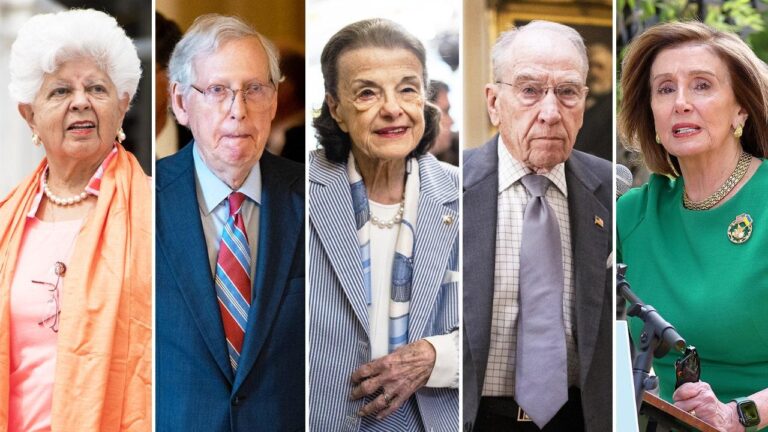In a landmark shift that is reshaping the landscape of American politics,The New York Times reveals that for the first time in history,more members of Congress are aged 70 and older than ever before. This unprecedented demographic trend raises critical questions about age, experience, and representation in the nation’s legislative body, as lawmakers grapple with complex challenges amid evolving societal expectations. The growing presence of septuagenarians and octogenarians in Congress underscores a broader debate over the balance between seasoned leadership and the need for generational diversity in Washington.
The Growing Senior Majority in Congress and Its Impact on Policy Making
As the senior demographic within Congress continues to swell,its influence on legislative priorities takes on increased significance. Lawmakers aged 70 and above now constitute a significant portion of the decision-making body,shaping policies with perspectives often shaped by decades of political and professional experience. This trend has led to a heightened focus on issues pertinent to older Americans, such as Social Security, Medicare, and retirement security, while sometimes triggering debates over the responsiveness of Congress to younger generations’ concerns like climate change and technology innovation.
Policy Implications of an Aging Congress Include:
- Increased advocacy for healthcare reforms targeting senior citizens.
- Greater emphasis on pension and entitlement program stability.
- Potential shifts in foreign policy reflective of past Cold War experiences.
- Challenges in addressing emerging technological and economic trends swiftly.
| Age Group | Percentage in Congress (%) | Key Legislative Focus |
|---|---|---|
| Under 50 | 20 | Technology, Education |
| 50-69 | 45 | Economy, Healthcare |
| 70 and over | 35 | Social Security, Foreign Policy |
Challenges and Opportunities of an Aging Legislative Body
As the average age of Congress members rises, the legislative body faces a unique set of challenges and opportunities. On one hand, a more experienced cohort brings decades of institutional knowledge, policy expertise, and historical perspective that can enhance lawmaking and foster bipartisan cooperation. However, concerns arise regarding the physical stamina and adaptability of older lawmakers, especially in an increasingly fast-paced political and technological landscape. Critics argue that this aging trend could hinder innovation and responsiveness, possibly alienating younger generations who seek more progressive representation.
Balancing age diversity within Congress has become a pressing discussion point. Advocates for a more varied age demographic emphasize the benefits of including younger voices that reflect contemporary societal issues such as climate change, technology regulation, and social justice. Meanwhile, seasoned legislators point to the valuable mentorship and leadership experience they provide. The evolving age composition brings both risks and potential, urging stakeholders to consider reforms that address term limits, retirement policies, and recruitment strategies. Here’s a rapid comparison of key aspects:
| Aspect | Older Legislators (70+) | Younger Legislators (<40) |
|---|---|---|
| Experience | Decades of service and institutional memory | Limited experience but fresh perspectives |
| Policy Focus | Traditionally broad and bipartisan | Progressive,tech,and social issues |
| Health & Endurance | Potential challenges with stamina | Generally higher stamina and energy |
| Electoral Appeal | Strong among established constituencies | Appeals to youth and emerging voters |
How Longevity Shapes Leadership and Institutional Knowledge in Congress
With the average age of Congress members steadily rising,the chamber is witnessing an era where experience is a defining asset. Lawmakers who have served multiple decades bring a deep reservoir of institutional knowledge that can guide complex legislative negotiations and policy growth. This longevity allows for the cultivation of relationships and trust that transcend partisan divides, frequently enough leading to more nuanced and historically informed decisions. However, it also raises questions about adaptability and the infusion of new ideas necessary to reflect a rapidly changing society.
Institutional memory in Congress acts as both a stabilizing force and a potential barrier to innovation. Veteran legislators often mentor newer members, passing down crucial insights about procedural tactics and long-term legislative strategies. The influence of seniority is evident in committee leadership roles and agenda-setting powers, highlighting how extended tenures shape governance. Yet, critics argue that the predominance of septuagenarians may hinder generational representation and the introduction of fresh perspectives vital for addressing emerging challenges.
- Advantages: Experienced leadership, strategic continuity, mentorship opportunities
- Challenges: Risk of stagnation, potential disconnect from younger constituents
| Factor | Impact of Longevity |
|---|---|
| Leadership Stability | High – fosters consistency in policy direction |
| Institutional Knowledge | Extensive – deep understanding of legislative history |
| Innovation | Moderate – potential resistance to change |
Recommendations for Addressing Representation and Diversity in Age
To foster a legislative body that truly mirrors the nation’s demographics, it is essential to implement policies that encourage age diversity among elected officials. One effective approach is to enhance mentorship programs that connect younger political aspirants with seasoned lawmakers, providing practical guidance and reducing barriers to entry. Additionally, political parties and advocacy groups should actively promote candidates across a broader age spectrum, ensuring that younger generations see themselves represented and empowered to run for office.
Structural reforms can also play a critical role in addressing age imbalances. Consider the advantages of age limits or phased retirement options that allow senior representatives to transition out gracefully, making room for fresh perspectives. Moreover, election cycles and campaigning methods can be adapted to better accommodate candidates of all ages, including flexible scheduling and leveraging digital platforms. The table below summarizes key recommendations that could reshape the age landscape in Congress:
| Suggestion | Objective |
|---|---|
| Mentorship Programs | Promote cross-generational knowledge transfer |
| Age Limits/Phased Retirement | Encourage gradual infusion of younger representatives |
| Party Diversity Initiatives | Support candidacies from diverse age groups |
| Flexible Campaigning | Adapt to varying needs of candidates |
Insights and Conclusions
As Congress continues to age, the implications for legislative priorities, representation, and governance remain a critical topic of discussion. With a growing number of lawmakers over 70, questions about experience, vitality, and generational perspectives are prompting renewed debates on the future direction of American politics.The evolving demographics of Capitol Hill underscore the need for ongoing analysis of how age influences policymaking and the broader democratic process.




